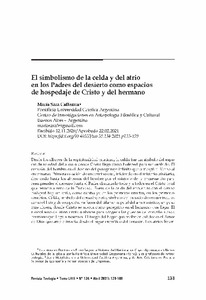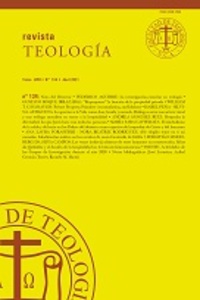Por favor, use este identificador para citar o enlazar este ítem:
https://repositorio.uca.edu.ar/handle/123456789/11599| Título: | El simbolismo de la celda y del atrio en los Padres del desierto como espacios de hospedaje de Cristo y del hermano The symbolism of the cell and the atrium in the desert Fathers as a lodging for Christ and fellow man |
Autor: | Cafferata, María Sara | Palabras clave: | SIMBOLISMO; PATRISTICA; TEOLOGIA; HOSPITALIDAD; PADRES DE LA IGLESIA; CRISTO | Fecha de publicación: | 2021 | Editorial: | Pontificia Universidad Católica Argentina. Facultad de Teología | Cita: | Cafferata, M. S. El simbolismo de la celda y del atrio en los Padres del desierto como espacios de hospedaje de Cristo y del hermano [en línea]. Teología. 2021, 58 (134). Doi: 10.46553/teo.58.134.2021.p133-150. Disponible en: https://repositorio.uca.edu.ar/handle/123456789/11599 | Resumen: | Resumen: Desde los albores de la espiritualidad cristiana, la celda fue un símbolo del espacio de soledad del alma a donde Cristo llega como huésped para ser recibido. El corazón del hombre es el destino del peregrinaje infinito que arriesgó el Verbo al encarnarse. Primera estación de un camino que, iniciando en el misterio trinitario, desciende hasta los abismos del hombre por el misterio de la encarnación para reemprender el ascenso hasta el Padre abrazando todo y a todos en el Cristo total que retorna a seno de la Trinidad. Fuera de la celda del encuentro con el divino huésped hay un atrio, como existía ya en las primeras ermitas, en los primeros cenobios. Celda, símbolo del corazón; atrio, símbolo del espacio de encuentro... es como el living de recepción, ya fuera del tálamo nupcial del amor místico, un paso más afuera, donde Cristo se acerca como peregrino en el hermano que llega. El simbolismo del atrio invita a abrirse para acoger a las puertas del corazón a cada hermano que llega a nosotros. El fuego del hogar que recibe en calidez es el Amor de Dios que arde e irradia desde el lugar eremítico del corazón. Los atrios fraternos de los diálogos de cielo como los de Benito y Escolástica o Agustín y Mónica o Teresita y sus hermanos se perfilan como sacramentos del Logos: signos sensibles del dialogo divino, participación y entrada en la Trinidad que es eterno Diálogo de Amor luminoso. Abstract: Since the dawn of Christian spirituality the cell has been a symbol of the soul's place of solitude, where Christ arrives and is received as a guest. The human heart is the final destination of that infinite Pilgrimage which the Word undertook when it became incarnate. It is the first stopping-place on a path that, beginning from the mystery of the Trinity, descends into the depths of man through the mystery of the Incarnation and then climbs again to the Father who embraces everything and everyone in the complete Christ who returns to the bosom of the Trinity. Outside the cell where the divine Guest is encountered there is an atrium, as was the case already in the first hermitages, the first monasteries. The cell, a symbol of the heart; the atrium, a symbol of the space of encounter — a receiving room, as it were, outside the nuptial chamber of mystic love, a step beyond it, where Christ approaches as a pilgrim in the brother who arrives. The symbolism of the atrium invites us to throw open the doors of the heart and embrace each brother as he reaches us. The hearth-fire that warms him as he comes in is the Love of God who burns and shines forth from within the hermitic space of the heart. The fraternal atria of the heavenly dialogues, like those of Benedict and Scholastica, Augustine and Monica, or Thérese of Lisieux and her brothers, come to be sacraments of the Logos: tangible signs of the divine dialogue, a way of entry and a participation in the Trinity, which is the eternal Dialogue of luminous Love. |
URI: | https://repositorio.uca.edu.ar/handle/123456789/11599 | ISSN: | 0328-1396 (impreso) 2683-7307 (online) |
Disciplina: | TEOLOGIA | DOI: | 10.46553/teo.58.134.2021.p133-150 | Derechos: | Acceso abierto | Fuente: | Teología. Tomo 58, Nro.134, 2021 |
| Aparece en las colecciones: | TEO - 2021 Tomo LVIII nro. 134 |
Ficheros en este ítem:
| Fichero | Descripción | Tamaño | Formato | |
|---|---|---|---|---|
| simbolismo-celda-atrio-padres.pdf | 7,88 MB | Adobe PDF |  Visualizar/Abrir | |
| cover_issue_348_es_AR.jpg | 10,55 kB | JPEG |  Visualizar/Abrir |
Visualizaciones de página(s)
292
comprobado en 27-abr-2024
Descarga(s)
108
comprobado en 27-abr-2024
Google ScholarTM
Ver en Google Scholar
Altmetric
Altmetric
Este ítem está sujeto a una Licencia Creative Commons

